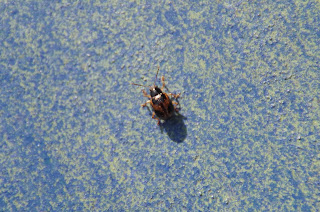One glorious green tree! The tree in the foreground is the one that suddenly died last summer, so it will not be turning green, but I am so longing for the others to follow the flowering crab apple tree's lead! But for now, it does me good every morning to open the shutters and look out upon that little oasis of verdure.
And here's some cute wildlife:
Now to our topic for today...
In nature, for many, if not most (or maybe all) creatures, there's always someone or something that would like to eat you, so in order to avoid being eaten, living things (and it's not just animals) have their ways of avoiding being devoured.
Bees, for instance:
They sting. Excellent defense mechanism. And their coloring acts as a warning to animals that this is danger (or so I have read).
And that means that for some other insects, if they just look like a bee, then they don't even have to have a stinger to be intimidating. They look like danger, and that is enough:
Like for this bee fly.
Sorry, they are very hard to photograph.
And that leads us to today's Backyard Bug of the Day:
Hummingbird clearwing moth.
There were a LOT of bumblebees in the rock garden today, and when this one arrived I thought it was another bumblebee, a really big one. But there was something about the way it flew that made me look more closely, and I realized it was actually a moth pretending to be a bumblebee. And the funny thing about this insect is that it looks like a bumblebee, flies like a hummingbird, and yet, it is a moth.
Check out that proboscis!
Also in the rock garden, along with a lot of bees, including other species besides bumblebees, and hummingbird moths, and two species of butterflies that did not want to be photographed (cabbage white and spring azure) there was an assassin bug. My not-very-profound observation of nature is that if there is something to eat, there will be something to eat it, and there are lots of bugs in the rock garden for an assassin bug to eat. It is interesting to note that I have seen assassin bugs feeding on bees. The stinger doesn't protect from everything.
Since we're on the topic of trying not to be eaten...
This beetle is about to demonstrate a tactic that beetles often use to deter predators...
... roll over and play dead. A more popular version of this is to roll off of whatever plant you're sitting on, but if you can't do that, just rolling over will do apparently. I have no idea why they do this, unless there are predators that don't want to eat something that is already dead, but that is just a guess.
More bugs:
I found this beetle swimming in a pool of rainwater in a plastic container. I rescued it–and dumped the rain water so mosquitoes would not lay eggs in the water. It's important not to leave standing water around.
The leafy spurge remains popular:
Bee on a bluet
Tent caterpillars
I have seen many more twice-stabbed lady beetles this year than I have ever seen before.
The pussy-willow flowers are still attracting a lot of bugs:
I'm not sure if you can tell from this picture, but there's bees here, and an assassin bug that has caught a bee.
Bees and an ambush bug
If this bee had stung me I would have gotten a great shot of it. I don't have any regrets about missing that shot.
Beetle on pussy-willow
Stilt-legged bug on daffodil
Click beetle
Winter fireflies.
Arachnid Appreciation:
.
.
.
.
.
.
.
.
.
.
.
.
All jumping spiders today:
This one has caught something.
This was taken about a second before it jumped onto my camera lens.
Snake of the Day:
.
.
.
.
.
.
.
.
.
.
.
.
This snake is so hard to spot lately. I look for it, don't see it, come back a minute later from a different direction and see it hiding among the leaf litter.
Down the hole















































No comments:
Post a Comment